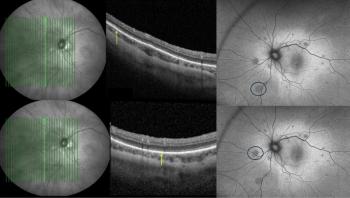
New pharmacological options for AMD
In an exciting time for the treatment of patients with exudative age-related macular degeneration, several new pharmaceutical options are being tested. Most compounds target vascular endothelial growth factor (VEGF), which is implicated in the proliferation of choroidal neovascularization. However, the effects of VEGF can be blocked at different levels.
In an exciting time for the treatment of patients with exudative age-related macular degeneration, several new pharmaceutical options are being tested. Most compounds target vascular endothelial growth factor (VEGF), which is implicated in the proliferation of choroidal neovascularization. However, the effects of VEGF can be blocked at different levels.
A number of new pharmacologic options for exudative age-related macular degeneration (AMD), mostly designed to block different steps in the angiogenic cascade, are in various stages of development and testing, and some may one day be shown to improve outcomes, said Michael J. Tolentino, MD, director of clinical research, Centre for Retina and Macular Disease, Winter Haven, Florida, USA.
"This is an exciting time for our patients with exudative wet AMD," Tolentino said in a presentation at the American Academy of Ophthalmology meeting in Chicago last year.
Targeting VEGF is key
He added that the way to achieve this goal is to involve therapies targeting vascular endothelial growth factor-A (VEGF-A), because wet AMD is characterized by chronic upregulation of VEGF-A. VEGF-A represents a family of VEGF proteins that are differentiated by their amino acid length. The shorter VEGF isoforms are soluble while the longer isoforms are bound. All these isoforms bind two main VEGF receptors that trigger neovascularization and permeability.
"I look at this whole interaction between VEGF and its receptors as the trigger that kicks off the neovascular cascade," Tolentino said. "When VEGF-A binds with VEGF receptor 2, this signals the vascular leakage and angiogenesis that results in wet AMD."
"How can we stop the effects of VEGF? Stopping VEGF before it binds to a receptor would prevent it from initiating that trigger," Tolentino continued. "The other way to do it is to stop it after VEGF has already triggered the whole neovascular cascade and block the downstream effects of VEGF."
Let's look at the options
Taking the first approach, VEGF can be stopped before it binds to a receptor by preventing its production through the destruction of VEGF messenger RNA (mRNA) levels, by neutralizing it once it is made, or by blocking the receptor. "If you don't stop VEGF before it binds its receptors, then you get neovascularization," Tolentino said.
Protein antagonists stop VEGF after it is made. Agents in this category include pegaptanib sodium (Macugen, OSI/Eyetech/Pfizer), bevacizumab (Avastin, Genentech), ranibizumab (Lucentis, Novartis/Genentech), and VEGF Trap (Regeneron Pharmaceuticals). Bevacizumab is the full-length antibody against VEGF and is the parent molecule of ranibizumab.
Pegaptanib is a VEGF aptamer, ranibizumab is an antibody fragment to VEGF, bevacizumab is a recombinant humanized antibody to VEGF, and VEGF Trap is a composite decoy receptor fusion protein that contains portions of the extracellular domains of two different VEGF receptors, VEGFR-1 and VEGFR-2, and can bind VEGF strongly. While they are all anti-VEGF agents, the compounds work slightly differently. Pegaptanib binds VEGF-165, an isoform important in angiogenesis and permeability, while ranibizumab, bevacizumab, and VEGF Trap bind all isoforms of VEGF-A.
These four compounds are in various stages of development and testing. "Macugen is approved and marketing authorizations have been filed in Europe and the US for Lucentis. Meanwhile, Avastin is currently being used off-label and Phase II clinical trials are being initiated for VEGF Trap," Tolentino advised.
Describing the mechanism of action of these compounds, Tolentino explained that they are injected into the eye and VEGF is taken up and neutralized within the extracellular space, "If you do not neutralize all the VEGF and some gets through, you will have continued vascular permeability and progression of neovascularization."
The positive side of using protein antagonists to treat wet AMD is the effectiveness of this neutralization process, while the negative side is that a sustained effect can only be achieved through repeated injections. "It's rather inefficient because there's a lot of VEGF being produced, and you need a molar excess of antagonist in order to neutralize all the VEGF produced," he added.
Newsletter
Get the essential updates shaping the future of pharma manufacturing and compliance—subscribe today to Pharmaceutical Technology and never miss a breakthrough.













































